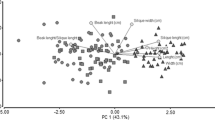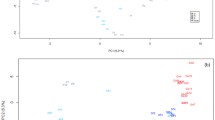Summary
The aim of this study was to evaluate the interest of beginning the selection process on a new genetic characteristic, cleistogamy, to manage gene flow in oilseed rape. The first step was to introduce this characteristic in an existing model of gene flow between oilseed rape populations in time and space, GeneSys-Rape. The second step was to evaluate the parameters of the model linked to this characteristic using field experimentations. Cleistogamous oilseed rape was shown to have an autogamy rate as high as 94% and to emit 10 times less pollen than an open-flowered oilseed rape in the same conditions. But the cleistogamous character was also shown to be unstable in the genotypes tested. The third step was to evaluate the interest of cleistogamy using simulations comparing several genotypes with or without cleistogamy in two different cropping systems. These simulations showed that an oilseed rape both dwarf and cleistogamous was interesting to limit gene escape and that a 99%-autogamous oilseed rape was interesting to limit both gene escape from and harvest contamination of the 99%-autogamous oilseed rape.
Similar content being viewed by others
References
Amsol, P., 2002. Dossier de presse “Point colza”: Colza le dynamisme des innovations génétiques conforte l'avenir de la filière. 8pp. http://www.amsol.asso.fr/actualites/colzadossierselection. pdf.
Angevin, F., N. Colbach, J.M. Meynard & C. Roturier, 2002. Task 3. Analysis of necessary adjustments of farming practices. In A. Bock, K. Lheureux, M. Libeau-Dulos, H. Nilsagard & E. Rodriguez-Cereso (Eds.), Scenarios for coexistence of genetically modified, conventional and organic crops in European agiculture. IPTS pp. 21–73.
Asseng, S., N.C. Turner, T. Botwright & A.G. Condon, 2003. Evaluating the impact of a trait for increased specific leaf area on wheat yields using a crop simulation model. Agronomy Journal 95: 10–19.
Barbottin, A. & M.H. Jeuffroy, 2004. The use of a crop model simulating the grain protein content of winter wheat to define breeding targets. In Workshop on modelling quality traits and their genetic variability for wheat, Clermont-Ferrand, France, 18–21 July 2004.
Becker, H.C., B. Karlsson & C. Damgaard, 1991. Genotypic and environmental variation for outcrossing rate in rapeseed. In GCIRC 1991 Congress, Saskatoon (Canada), pp. 1454–1459.
Boote, K.J., J.W. Jones & N.B. Pickering, 1996. Potential uses and limitations of crop models. Agronomy Journal 88(5): 704–716.
Chapman, S., M. Cooper, D. Podlich & G.L. Hammer, 2003. Evaluating plant breeding strategies by simulating gene action and dryland environment effects. Agronomy Journal 95: 99–113.
Colbach, N., C. Clermont-Dauphin & J.M. Meynard, 2001a. GeneSys: A model of the influence of cropping system on gene escape from herbicide tolerant oilseed rape crops to rape volunteers II. Genetic exchanges among volunteer and cropped populations in a small region. Agric., Ecosystems Environ 83: 255–270.
Colbach, N., C. Clermont-Dauphin & J.M. Meynard, 2001b. GeneSys: A model of the influence of cropping system on gene escape from herbicide tolerant rapeseed crops to rape volunteers. I. Temporal evolution of a population of rape volunteers in a field. Agric Ecosystems Environ 83: 235–253.
Colbach, N., A. Fargue, C. Sausse & F. Angevin, 2005a. Evaluation and use of a spatio-temporal model of cropping system effects on gene flow. Example of the GENESYS model applied to three co-existing herbicide tolerance transgenes. European Journal of Agronomy 22: 417–440.
Colbach, N., N. Molinari, J.M. Meynard & A. Messéan, 2005b. Integrating spatial aspects into sensitivity analyses for models simulating demography and genotype evolutions with time. Application to GENESYS modelling gene flowbetween rapeseed varieties and volunteers. Agronomy for Sustainable Development 25: 355–368.
Delourme, R. & F. Budar, 1999. Male sterility. In Biology of Brassica Coenospecies, Ed. Gomez-Campo C. pp. 185–216.
Eisikowitch, D., 1981. Some aspects of oilseed rape. J Agric Sci Camb 96: 321–326.
Fargue, A., J.M. Meynard, N. Colbach, P. Vallee, G. Grandeau & M. Renard, 2004. Contamination of rapeseed harvest by volunteers of other varieties: a study of intergenotypic competition. European Journal of Agronomy 21: 193–207.
Fargue, A., N. Colbach & J.M.Meynard, 2005. Introduction of genotypic effects into GeneSys-Rape: Effects of height and male sterility on gene flow between rape populations. Agric Ecosystems Environ 108: 318–328.
Hails, R.S., M. Rees, D.D. Kohn & M.J. Crawley, 1997. Burial and seed survival in Brassica napus subsp. oleifera and Sinapis arvensis including a comparison of transgenic and non-transgenic lines of the crop. Proc Royal Soc London B 264: 1–7.
Hoogenboom, G. & J.W. White, 2003. Improving physiological assumption of simulation models by using gene-based approaches. Agronomy Journal 95: 82–89.
Lavigne, C., B. Godelle, X. Reboud & P.H. Gouyon, 1996. A method to determine the mean pollen dispersal of individual plants growing within a large pollen source. Theor Appl Genet 93: 1319–1326.
Lavigne, C., E.K. Klein, P. Vallée, J. Pierre, B. Godelle & M. Renard, 1998. A pollen-dispersal experiment with transgenic oilseed rape. Estimation of the average pollen dispersal of an individual plant within a field. Theor Appl Genet 96: 886–896.
Lewis, L.J. & D.L. Woods, 1991. Outcrossing in summer oilseed rape (Brassica napus L.) under Peace River, Alberta conditions. In GCIRC 1991 Congress, Saskatoon (Canada), pp. 1528–1531.
Mesquida, J. & M. Renard, 1982. Etude de la dispersion du pollen par le vent et de l'importance de la pollinisation anémophile chez le colza. Apidologie 13: 353–366.
Olsson, G., 1960. Self-incompatibility and outcrossing in rape and white mustard. Hereditas 46: 241–252.
Pelletier, G., C. Grimard, F. Vedel, P. Chétrit, R. Rémy & M. Renard, 1983. Intergeneric cytoplasmic hybridization in Cruciferae by protoplast fusion. Mol Gen Genet 191: 244–250.
Pierre, J. & M. Renard, 1999. Plant development mutants: Incidence on honey bees behaviour and pollination. In 10th International Rapeseed Congress, Canberra (Australia), 5p.
Pierre, J. & M. Renard, 2000. Variabilité du comportement de butinage de l'abeille domestique (Apis mellifera) sur des mutants de colza (Brassica napus oleifera). Conséquence pour la pollinisation. Actes des colloques des Insectes sociaux 13: 35–42.
Pierre, J., H. Picault, X. Tanguy & M. Renard, 2002. La cléistogamie chez la fleur de colza empêche-t-elle la dispersion du pollen par les insectes pollinisateurs. In C.R. AIP OGM et environnement, INRA ed., pp. 104–107.
Pierre, J., D. Marsault, E. Genecque, M. Renard, J. Champolivier & M.H. Pham-Delègue, 2003. Effects of herbicide tolerant transgenic oilseed rape genotypes on honeybees and other pollinating insects under field conditions. Entomologia Experimentalis et Applicata 108: 159–168.
Renard, M. & X. Tanguy, 1997. Obtention de mutants cléistogames de crucifères. Brevet FR 97 15768.
Rives, M., 1954. Le système de reproduction du colza. Sa signification du point de vue de la théorie polygénique de l'hérédité des caractères quantitatifs. Ann.s de l'INRA, série B Ann. d'Amélioration des Plantes 4: 21–31.
Scheffler, J.A., R. Parkinson & P.J. Dale, 1993. Frequency and distance of pollen dispersal from transgenic oilseed rape. Transgenic Research 2: 356–364.
Thompson, C.E., G. Squire, G.R. Mackay, J.E. Bradshaw, J. Crawford & G. Ramsay, 1999. Regional patterns of gene flow and its consequences for GM oilseed rape. In Gene Flow and Agriculture, relevance for transgenic crops, Ed. Lutman P.J.W. BCPC, Keele (U.K.), pp. 95–100.
Vocanson, A., M.H. Jeuffroy, G. Etévé & S. Terrier, 2004. The use of crop modelling to help plant breeders in determining the selection criteria of the future winter pea varieties (Pisum sativum L.). In Proceedings of the 5th European Conference on grain legumes, Dijon, France, 7–11 June 2004, pp. 129.
Author information
Authors and Affiliations
Corresponding author
Rights and permissions
About this article
Cite this article
Fargue, A., Colbach, N., Pierre, J. et al. Predictive study of the advantages of cleistogamy in oilseed rape in limiting unwanted gene flow. Euphytica 151, 1–13 (2006). https://doi.org/10.1007/s10681-005-9005-3
Received:
Accepted:
Published:
Issue Date:
DOI: https://doi.org/10.1007/s10681-005-9005-3




